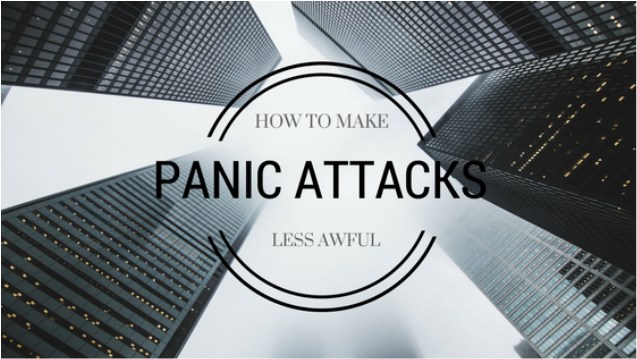|
Dr. Hannah Singer One minute you’re casually cruising the aisle of the grocery store deciding between cheddar and colby jack and the next you feel a wave of fear wash over your entire body. Your heart starts pounding. Your chest feels tight. You suddenly feel like you’ve come down with a flu… or food poisoning... on a roller coaster.... With an elephant sitting on your chest. Sound familiar? I’m not gonna sugar coat it. Panic attacks suck. Luckily, there are some powerful techniques to make them suck a little less. What is a panic attack?“I’m having a panic attack” has become a popular figure of speech, but a true panic attack is different than feeling mildly overwhelmed, flustered, or nervous. A panic attack is a sudden rush of intense fear accompanied by at least 4 of the following symptoms
Panic attacks come on suddenly and reach a peak within a few minutes. They typically last about 10 minutes, however, some symptoms may ebb and flow over the course of several hours. There are two types of panic attacks:
If you find yourself limiting or avoiding certain places, situations, or activities due to fear of having a panic attack, I highly recommend seeking help from a qualified mental health professional who will teach you effective tools to reduce panic, stop avoiding, and get back to living your life! Are they dangerous?The #1 most important thing to remember while in the midst of a panic attack is that they are not dangerous. Extremely frightening and uncomfortable? Absolutely! But, not dangerous. Still, it’s always a good idea to get checked out by a doctor to rule out medical causes of panic symptoms. Getting a clean bill of health will also give you peace of mind - if you happen to have another panic attack, you will be able to reassure yourself that you are not in any danger. What is a panic attack? It’s a completely natural and harmless bodily process (activation of the emergency fight-or-flight response) that gets turned on out of context. Your brain mistakenly perceives a cue in your environment as a threat and signals your body to secrete a large amount of adrenaline and cortisol to prepare to fight or flee from the supposed danger. It’s this surge of hormones that causes all the uncomfortable physical symptoms. Negative Feedback LoopIt is very common for people to interpret their panic attack symptoms as being dangerous, which actually adds fuel to the fire and prolongs the panic attack. For example, some people think “my heart is beating so fast that I am going to have a heart attack” (You won’t. A healthy heart can beat up to 200 beats per minute for weeks without causing long-term damage, so a panic attack will not cause heart failure.) When you interpret your bodily symptoms as dangerous, your brain is now creating imaginary danger and ramping up your fight-and-flight system even more. Moral of the story is, the more you can just ride it out and observe the uncomfortable feelings of the panic attack without engaging in catastrophic thoughts, the sooner the panic symptoms will subside. Once the body sees it made a mistake and there is no real danger, it will turn off the alarm system. The surge of adrenaline that was released into your body will break down and be reabsorbed within three to five minutes and you will begin to feel better. 5 Tips to "Ride it Out"What can you do to interrupt this negative feedback loop and make it easier to "ride it out"? Here are some simple, but effective methods.
So there you have it. Five simple, but powerful techniques to stop the negative feedback loop that prolongs a panic attack and make it a little less awful. Hope these are helpful! If fear of having additional panic attack is affecting your quality of life (ie: you’re avoiding situations like driving because you’re scared of having an attack and losing control) I encourage you to seek help from a therapist experienced in treating anxiety disorders. It’s important to know that you are not alone and Panic Disorder can be effectively treated with therapy and/or medication. In my practice, I have helped many individuals drop their struggle with panic and anxiety. If you're interested in working with me in individual therapy, click here to learn more. Do you have other techniques that are helpful for managing panic attacks? Feel free to share them in a comment below!
0 Comments
Your comment will be posted after it is approved.
Leave a Reply. |
About.I'm a clinical psychologist and adult psychotherapist based in Los Angeles. I specialize in treating anxiety, trauma, and perinatal mental health using traditional talk therapy, mindfulness-based therapy, and EMDR. Stay postedCategories
All
Archives
March 2020
|


 RSS Feed
RSS Feed